Description
Following is the blazon narrative describing the Vermont Veterans Medal:

In heraldry and heraldic vexillology, a blazon is a formal description of a coat of arms, flag or similar emblem, from which the reader can reconstruct the appropriate image. The verb to blazon means to create such a description. The visual depiction of a coat of arms or flag has traditionally had considerable latitude in design, but a verbal blazon specifies the essentially distinctive elements. A coat of arms or flag is therefore primarily defined not by a picture but rather by the wording of its blazon. Blazon also refers to the specialized language in which a blazon is written, and, as a verb, to the act of writing such a description. This language has its own vocabulary, grammar and syntax, which becomes essential for comprehension when blazoning a complex coat of arms.
The ribbons of the Vermont medals for veterans contain the four primary colors of the Coat of arms of Vermont: red, yellow, blue and green.

The coat of arms of Vermont is the official armorial bearings of the U.S. state of Vermont. Most of the elements found in the coat of arms originate in the Great Seal of Vermont designed by Ira Allen. Whereas the Great Seal of Vermont is reproduced in a single color and is reserved for embossing and authenticating state documents, the coat of arms is a more naturalistic and colorful representation of many of the same elements. The Coat of arms of Vermont was first used in 1807 on $5 bank notes of The Vermont State Bank. One of these notes is in the special collections of the Vermont History Center in Barre, Vermont. Prior to the discovery of the 1807 banknotes, the earliest representation of the coat of arms of Vermont was found on an engraved 1821 state military commissions. The exact designer is not known, but it is likely that then Secretary of State Robert Temple worked with an engraver in developing the arms. Considerable liberties were taken in early depictions of the coat of arms. The location of the cow and the sheaves moved about the foreground, and the height of the pine tree and size of the buck's head also varied. A state statute was approved in 1840, and modified in 1862, both attempts to codify and create more consistent representation of the arms. The coat of arms was cast in brass to ornament uniforms of Vermont's military regiments before, and through the U.S. Civil War, when individual states raised and trained their own regiments.
The alternating red and yellow at the center of the ribbon loosely parallels the design and colors of the National Defense Service Medal, which is presented to military members with service during a time of conflict.
Field of azure blue encompasses the red and yellow, symbolizing the honor of military service.
Next, fields of green represent Vermont, the Green Mountain State, which reminds us that service to our nation is also service to the citizens of our state.
The edges of this ribbon are bordered in yellow. In the Vermont Coat of Arms, bundles of wheat are shown in yellow. In this ribbon, they represent the protection offered our state by nature’s bounty.
The medal is cast in bronze, with the coat of arms of Vermont on the obverse and the Great Seal of Vermont on the reverse. Across the top is inscribed “Vermont National Defense,” uniting the interests of our state with our nation.
The year “1777” is inscribed at the bottom, indicating the year of the Battle of Bennington where Vermonters first took arms to defend their state in war, and the year of the founding of the Vermont Republic.

The Battle of Bennington was a battle of the American Revolutionary War, part of the Saratoga campaign, that took place on August 16, 1777, in Walloomsac, New York, about 10 miles (16 km) from its namesake Bennington, Vermont. A rebel force of 2,000 men, primarily New Hampshire and Massachusetts militiamen, led by General John Stark, and reinforced by Vermont militiamen led by Colonel Seth Warner and members of the Green Mountain Boys, decisively defeated a detachment of General John Burgoyne's army led by Lieutenant Colonel Friedrich Baum, and supported by additional men under Lieutenant Colonel Heinrich von Breymann.
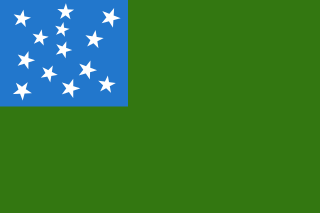
The Vermont Republic is a term used by historians to refer to the government of Vermont that existed from 1777 to 1791. In January 1777, delegates from 28 towns met and declared independence from the jurisdictions and land claims both of the British colony of Quebec and of the American states of New Hampshire and New York. They also abolished adult slavery within their boundaries. Many people in Vermont took part in the American Revolution, although the Continental Congress did not recognize the jurisdiction as independent. Because of vehement objections from New York, which had conflicting property claims, the Continental Congress declined to recognize Vermont, then known as the New Hampshire Grants. Vermont's overtures to join the Province of Quebec were accepted by the British, offering generous terms for the Republic's reunion. When the main British army surrendered in 1781, however, American independence became apparent. Vermont, now surrounded on three sides by American territory, rejected the British overtures and instead negotiated terms to enter the United States. In 1791, Vermont officially joined the United States as the 14th state.

The state flag of Moldova is a vertical tricolour of blue, yellow, and red, charged with the coat of arms of Moldova on the center bar. The obverse is mirrored. The flag ratio is 1:2. Until further provisions, the State Flag of Moldova is used as the national flag and ensign as well, that is, civil, state and war flag and ensign.
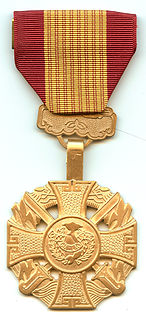
The Republic of Vietnam Gallantry Cross also known as the Vietnamese Gallantry Cross or Vietnam Cross of Gallantry is a military decoration of the former Government of South Vietnam. The medal was created on August 15, 1950 and was awarded to military personnel, civilians, and Armed Forces units and organizations in recognition of deeds of valor or heroic conduct while in combat with the enemy.
The Vietnam Service Medal is a military award of the United States Armed Forces established on 8 July 1965 by order of President Lyndon B. Johnson. The medal is awarded to recognize service during the Vietnam War by all members of the United States Armed Forces provided they meet the award requirements.

The Marksmanship Medal is a United States Navy and the U.S. Coast Guard military award and is the highest award one may receive for weapons qualification. The Marksmanship Medal is the equivalent of the Expert Marksmanship Badge in the U.S. Army and U.S. Marine Corps. Additionally, select State National Guard organizations award marksmanship medals to guardsman who achieve some of the highest aggregate scores at state-level marksmanship competitions.
Awards and decorations of the National Guard are presented to members of the United States National Guard and sometimes to members of the state defense forces in addition to regular United States military decorations. Each of the state governments of the United States maintains a series of military decorations for issuance to members of the National Guard, with such awards presented under the authority of the various state adjutants general.

The Spanish War Service Medal was a United States military medal of the U.S. Army which was established by an act of the U.S. Congress on 9 July 1918. The medal recognizes those members of the Army and of the U.S. Volunteers who performed active duty during the Spanish–American War, but did not qualify for the Spanish Campaign Medal.
Awards and decorations of the United States Air Force are military decorations which are issued by the Department of the Air Force to Air Force service members and members of other military branches serving under Air Force commands. Of all five branches of the United States Armed Forces, the United States Air Force currently maintains the highest number of active awards and decorations, including many without equivalent in any other service.

The Wisam Al-Tahrir was issued by the government of Kuwait for service during the Liberation of Kuwait campaign, 1990–91.
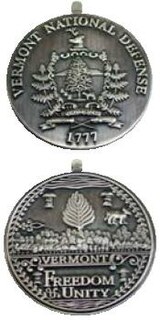
The Vermont Distinguished Service Medal is awarded to U.S. veterans from Vermont who served in a combat theater. The medal was established in 1999, but is retroactively available to veterans of prior military service.

The Dekoratie voor Trouwe Dienst, post-nominal letters DTD, is a South African military decoration. It was instituted in 1920 as a retrospective award for Boer officers of the 1899–1902 Second Boer War.

The Medalje voor de Anglo-Boere Oorlog is a South African military campaign medal. It was instituted on 21 December 1920 as a retrospective award for Boer veteran officers and men who fought in the 1899–1902 Second Boer War.
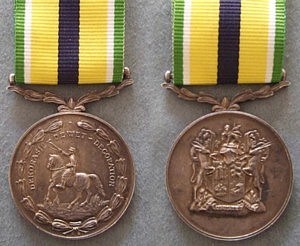
The De Wet Decoration, post-nominal letters DWD, is a military long service decoration which was instituted by the Republic of South Africa in 1965. It could be awarded to members of the Commandos, the rural civil defence component of the South African Defence Force, for twenty years of efficient service and good conduct. The decoration was initially reserved for officers, but it was made available to all ranks in 1986. A clasp could be awarded after thirty years service.

The Mississippi State Guard (MSSG) is the state defense force of Mississippi. It operates under the authority of the Mississippi Military Department alongside the Mississippi Army National Guard (MSARNG) and the Mississippi Air National Guard (MSANG).

The South Carolina State Guard (SCSG) is the designated state defense force for the state of South Carolina.
Colombian military decorations date back as far as the founding of the country. An early decoration was the Cruz de Boyacá that was awarded to the generals who led their forces to victory in the Battle of Boyacá in 1819. This early decoration lives on today as an incarnation of the highest order presented by the Colombian state. There is one decoration higher, but it is only awarded for military conflicts in defence of Colombia. Other than military decorations, Colombia presents decorations on behalf of the National Government, decorations for the National Police, and decorations from the Congress of Colombia.
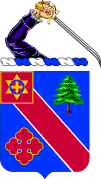
The 211th Military Police Battalion is a unit of the Massachusetts Army National Guard. Its Headquarters and Headquarters Detachment is descended from the First Corps of Cadets, initially formed in 1741. Its motto is Monstrat Viam – "It Points the Way." While it has served in five wars, the sub-unit's primary contribution to Massachusetts and to the United States was as an officer-producing institution for new regiments from the Revolutionary War through World War II.

The Faithful Service Medal was instituted by the State President of the Republic of Transkei in 1987, for award to all ranks as a long service medal.
The Medal for Service in War Overseas is a military decoration awarded by Colombia. Established in 1952, the medal was awarded in two classes to members of the Military Forces of Colombia who distinguished themselves in action during the Korean War.
The General Service Medal is a service medal of Malaysia. It is awarded for general service to members of the military and uniformed services of Malaysia. It ranks 26th in the order of wear of the Orders, decorations, and medals of Malaysia.
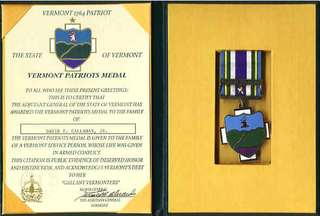
The Vermont Patriots Medal is an award of the state of Vermont. It is presented to the next of kin of each Vermont military service member who is killed in armed conflict. The award was first authorized in 1966, during the Vietnam War, but presentations did not commence until 1996.



















